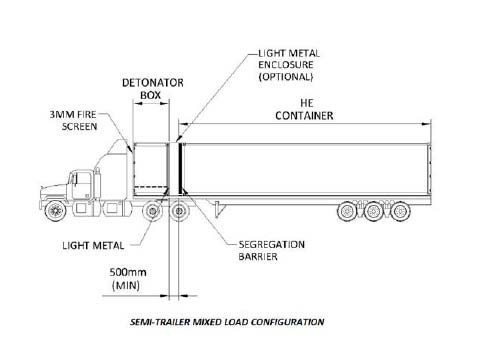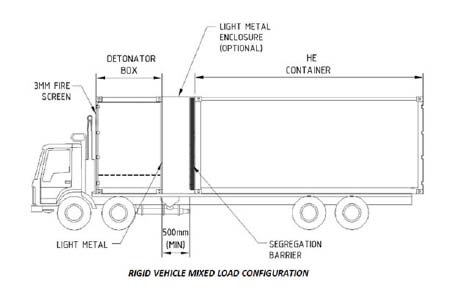
Explosives information bulletin no. 76 | 17 April 2013 | Version 1
Transporting Category 3 mixed loads of detonators and high explosives
The Australian Explosives Industry and Safety Group Incorporated (AEISG) has published the Code of Practice Segregation barriers for transporting mixed loads of detonators and high explosives edition 1 dated June 2012 (AEISG COP Segregation barriers).
The requirements for the transportation of mixed loads of detonators and high explosives are dependent upon the classification of the detonators being transported, i.e. hazard division 1.1 (HD 1.1) or hazard division 1.4 (HD 1.4) and hence when segregation barriers, separate carry boxes and containers are applicable. This bulletin outlines the requirements for the loading of mixed loads of detonators and high explosives on the same vehicle.
The applicable sub-sections of section 7.3.2 of the Australian code for the Transport of explosives by road and rail 3rd edition (AEC3) are included below.
Mixed loads: detonators of HD 1.1 with high explosive
Under sub-section 7.3.2(5) of AEC3, the AEISG COP Segregation Barriers is approved by the Chief Inspector of Explosives as a method for transporting detonators of HD 1.1 with high explosives on the same vehicle.
Features of this approved method include the following:
- 10,000 detonators maximum within the detonator box (including electric, electronic, non-electric but not including plain detonators, elemented caps or other detonator components).
- Each segregation barrier, HE container and detonator box must be fitted with a compliance plate. (The compliance plate demonstrates that the segregation barrier, HE container and the detonator box comply with the AEISG COP Segregation Barriers and have been certified by an engineer. All existing detonator boxes and HE containers will be fitted with current compliance plates before August 2013).
- Only detonators can be transported in the detonator box in mixed load configurations.
- A 500mm minimum gap must exist between the detonator box and the Segregation Barrier.
- A vertical firescreen complying with sub-section 6.4.2(2)(b) of AEC3 must be provided between the vehicle cabin and the explosives load.
- A horizontal firescreen of not less than 3mm steel must be provided for all of the detonator box or enclosed vehicle body (refer sub-section 6.4.2(2)(a) of AEC3).
- Only detonators or high explosive can be loaded into a HE container but not both in the mixed load configuration.
Detonator boxes and HE containers with Segregation Barriers, without a compliance plate as outlined in the AEISG COP Segregation Barriers, will be accepted until 31 August 2013.
If detonators of HD 1.1 are transported with detonators of HD 1.4, the detonators are all treated as HD 1.1 as outlined in Table 7.1 of AEC3.
Configuration: body truck and semi-trailer
For mixed loads involving detonators of HD 1.1 on a body truck or semi-trailer, only detonators can be transported in the detonator box and high explosives can be transported in the HE container. Refer to the diagrams below. (All diagrams reproduced with permission from AEISG.)
Configuration: b doubles
For mixed loads involving detonators of HD 1.1 in b double combinations, detonators must be transported in the detonator box. The HE containers may be used for either detonators or high explosive in a mixed load combination. Refer to the table below for the three possible options; and the image below for vehicle combination.
Satisfactory load arrangements
| Front – HE container | Middle – detonator box | Rear – HE container |
|---|---|---|
| High explosives | Detonators H D 1.1 | High explosives |
| Detonators HD 1.1 | Detonators H D 1.1 | High explosives |
| High explosives | Detonators H D 1.1 | Detonators H D 1.1 |
Mixed loads: detonators of HD 1.4 with high explosive
For mixed loads involving detonators of HD 1.4 being transported with high explosives, there are no restrictions on the loading of detonators and high explosives in any particular compartment or container but they must not be loaded together within the same compartment or container. This applies on body trucks, semi-trailers and b doubles. The requirements of sub-section 7.3.2.(7) of AEC3 apply and hence the requirements of AEISG COP Segregation barriers do not apply.
Loads of detonators or high explosive only on the vehicle
There are no restrictions on detonators or high explosives being loaded into either the detonator box or HE container.
Background: Applicable requirements from AEC3 Section 7.3.2
7.3.2 (3) Unless segregated in accordance with Section 7.3.2(5) or (6) explosives in different Compatibility Groups, regardless of Division, must not be transported together except where permitted by Table 7.2.
7.3.2 (5) Explosives not normally permitted by Section 7.3.2(3) to be transported together, may be transported on the same vehicle provided the incompatible explosives are segregated by:
- an effective means of segregation demonstrated to prevent sympathetic detonation of the incompatible explosives
- other means specifically approved by a Competent Authority for that purpose.
7.3.2(6) Detonators of Classification Code 1.1B must not be transported on the same vehicle as other explosives except in accordance with an approved method (see Section 7.3.2(5)), or under the following conditions:
- the quantity of detonators does not exceed the upper Category 1 limit
- the total quantity of explosives does not exceed the upper Category 2 limit which applies for the Division assigned to the load
- detonators must be separated from other explosives by at least 2 metres, or a lesser distance where separated by sufficient means to prevent fire or explosion communicating from the detonators to the other explosives.
7.3.2 (7) Detonators of Classification Code 1.4B or 1.4S may be carried with other explosives on the same vehicle provided they are in a separate carry box or compartment from the other explosives.
Contact: Manager, Explosives Licensing , +61 7 3199 8057 explosives@dnrm.qld.gov.au
Issued by Queensland Department of Natural Resources and Mines
Find more safety notices
Search the hazards database


